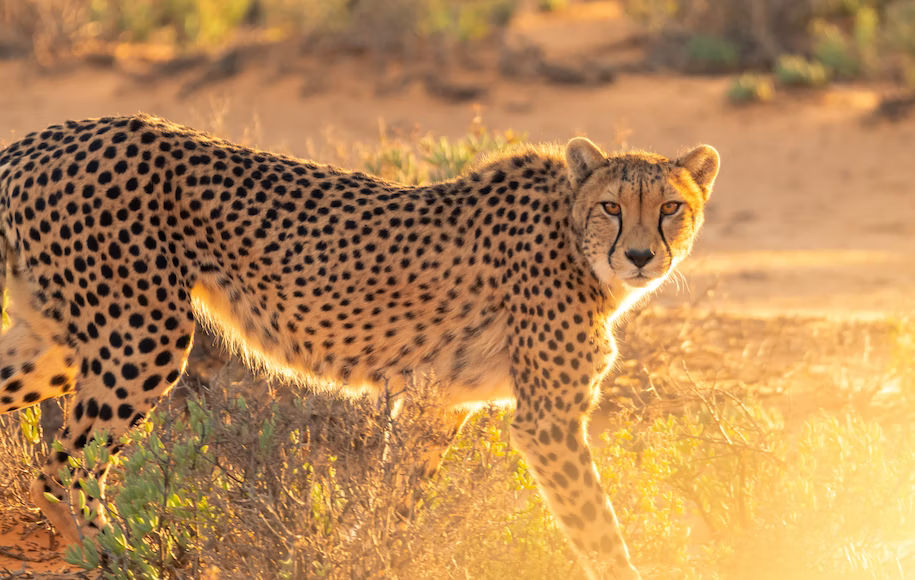Eight African Cheetahs were transported from Namibia to Madhya Pradesh’s Kuno National Park as part of an effort to reintroduce cheetahs to India after the Asiatic Cheetah became extinct in the 1950s due to uncontrolled hunting.
This cheetah reintroduction into the Indian landscape or Project Cheetah, as it is officially called, is presumed to be the world’s first intercontinental translocation. However, since then-environment minister Jairam Ramesh proposed the translocation in 2010, it has been fraught with difficulties and controversy.
Also read: Why African cheetahs were not fed during transportation to India
Primarily, several wildlife biologists and wildlife specialists have questioned whether India can provide enough land and resources for cheetahs to thrive yet again. According to Arjun Gopalaswamy, an independent conservation scientist quoted by National Geographic, “There’s not any chance for free-ranging cheetah populations now. Cheetahs in India perished for a reason… so the first question is, Why is this attempt even being made?”
Other big cats, such as tigers and lions, have a dwindling and disconnected wilderness in India. As a result, other conservationists claim that this is nothing more than a vanity project.
Also read: As Namibian cheetahs arrive in India, officials claim population of big cats grew under PM Modi
Ravi Chellam, a wildlife biologist and conservation scientist, asserted on July 21, when Namibia and India signed a deal to transfer eight African Cheetahs to India, “This is not a conservation priority for India. If the introduction of African cheetah is so important, why doesn’t it figure in our National Wildlife Action Plan? The Asiatic Lion does figure in it. It’s a vanity project. Isn’t the Asiatic Lion as a predator higher up the food chain than the cheetah? All the ecological roles and functions claimed as benefits from the introduction of African Cheetahs would be more than fulfilled by the translocated lions.”
Also read: Who was Maharaja Ramanuj Pratap Singh Deo, man responsible for killing India’s last cheetahs?
Another significant reason for widespread opposition to the project is that Kuno National Park was originally recognised for the translocation of the Asiatic Lion from Gujarat’s Gir, where an isolated population of around 600 is still surviving but is challenged due to a lack of genetic diversity and a larger range dispersion for their habitat.
The government, on the other hand, was opposed to relocating the Asiatic Lion to Kuno. Why? “That’s a political issue,” said a senior official in the environment ministry. “It’s completely hypothetical with no science to explain.”
On July 25, in response to a question from Bharatiya Janata Party (BJP) Member of Parliament Sanjay Patil, Ashwini Kumar Choubey, Minister of State for Environment, informed Lok Sabha that “a committee was constituted by the ministry of environment, forest and climate change to assess the suitability of habitat for lions in potential sites in Gujarat and make recommendations regarding the facilitation of the natural dispersal of lions and the modalities for the establishment of the lion population in newly identified sites in the state of Gujarat.”
Also read: Cheetahs at Kuno National Park: Total money spent on the operation
These personable animals are also political symbols, with state and federal governments viewing them as ambassadors for specific states, according to officials.
The Supreme Court granted the Centre permission to introduce the African Cheetah to a suitable habitat in India on January 28, 2020. As the court monitors the government’s ambitious project, it was hearing an application filed by the National Tiger Conservation Authority (NTCA) seeking permission for the initiation of the African Cheetah from Namibia.
The Supreme Court established a three-member committee comprised of the former director of the Wildlife Trust of India (WTI), Ranjitsinh, a retired Indian Forest Service officer, and officials from the environment ministry to advise the NTCA on the issue.
The Kuno National Park is only 748 square kilometres in size. According to Laurie Marker, executive director of the Cheetah Conservation Fund (CCF), who is coordinating the big cat translocation from Namibia, the habitat in Kuno is similar to that of the African Cheetah in Namibia or South Africa and is highly favorable.
Also read: Watch: PM Narendra Modi releases African cheetahs at Kuno National Park
According to CCF research, cheetahs have a large home range of about 1500 square kilometres in Namibia’s semi-arid regions. They predicted that home range size requirements in India would be lower due to more productive habitats.
“It is imperative that potential threats to cheetahs at release sites be addressed, or plans are in place to mitigate the threat. A habitat suitability study should be conducted at each site to ensure there is sufficient vegetation to support viable prey populations to sustain the introduced cheetahs for the long-term. Such studies have already been conducted at potential release sites. The reintroduced population needs to be protected from anthropogenic threats, and the potential impact of unnaturally high competition among cheetahs and with other predators needs to be managed,” CCF said in a statement.
Also read: Asiatic cheetah extinction: How Indian cheetahs disappeared
Hindustan Times reported that Marker noted that cheetahs must remain an isolated population in Kuno, but that a metapopulation should be allowed to emerge over time. Cheetahs are somewhat very adaptable and were widely distributed until about a century ago. They will be able to withstand the majority of the climate conditions in India.
Temperatures in parts of Africa where cheetahs live can range from extremely hot during the day to extremely cold at night, and cheetahs can adapt to seasonal changes. Cheetahs hunt best in open savannahs and grasslands, but they can also be found in areas with moderate woody vegetation cover, according to CCF’s FAQ.
Also read: The journey of eight cheetahs from Namibia to India
In India, however, instead of fast-moving land mammals like impalas and gazelles, they will now rely on chital, sambars, nilgai, wild pig, chowsingha, langur, and other species. Cheetah numbers will be augmented annually from Namibia and South Africa to ensure a sustainable population in Kuno and other Indian national parks.






